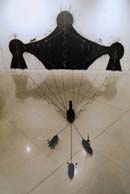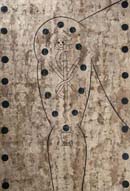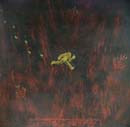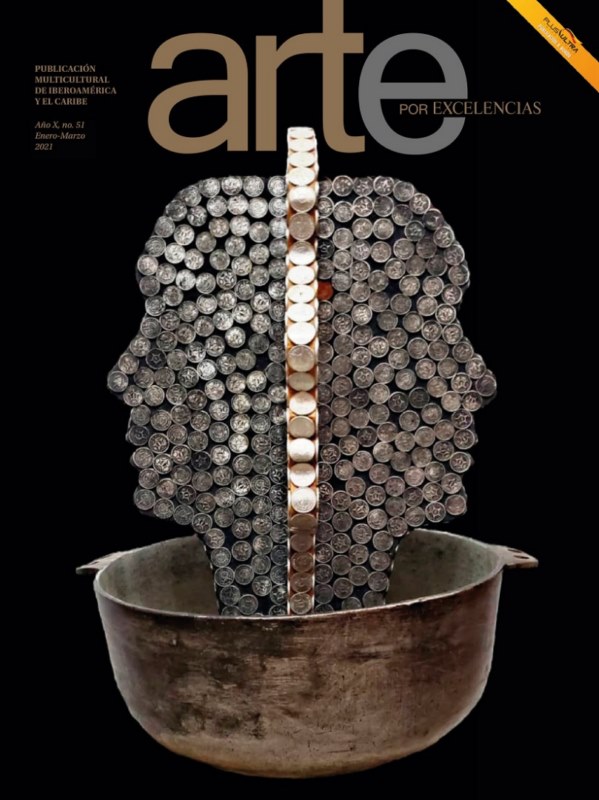Unlike artists whose esthetics have been more or less centripetal –that is, art-centric, directed toward the historic vortex of the Western culture– Jose Bedia’s has proved to be, on the contrary, completely fugitive and centrifugal. And since this centrifugal trend can only be pushed to the edges, toward the margins, his esthetics has always pointed to the so-called –from the center– peripheral cultures that, in our particular case as Cuban, Caribbean and Latin American, might as well be called “our cultures.” And even though it’s true that a good deal of what we call our cultures has long belonged to the modern West, another part of it has refused to enter that realm. Their ties to that modern West are barely slight, ornamental and external. And it’s above all that resistant, stubborn, nonnegotiable part of our cultures what this article is referred to. And what of those parts has Bedia’s esthetics focused on? Probably on all of them, but mainly on those hailing from Africa and America. As far as America is concerned, there’s no need to make a distinction among the North, Central or South, with the Caribbean floating in the middle like somewhat authonomous or independent fragments –the way nationalism’s political geography has taught us to look at them. Aside from their undisputed local particularities, there’s a sort of common denominator among all of them that allows for comprehension of them as a whole. Anyone might think that common denominator has to do with such issues as magic, religion or cosmos-centric visions that many of these cultures share, or with the respectful and harmonious character of their approach to nature, or with a particular thinking –and language– of mythical and symbolic character that differs from the logical and rational ones that prevail in the Western and westernized modern cultures. All this much is true. Yet it provides us with an incomplete, insufficient vision of the phenomenon. A vision that tends to be idyllic, non-problematic and therefore discreetly misleading. The joy of discovering and making visible equivalents, kinships or “family resemblances” among elements from these cultures, sometimes geographically distant –which has been one of Jose Bedia’s great artistic and intellectual achievements– could be involuntarily covering up other truths; somewhat bitter and painful truths. In our judgment, this “grand unit” lies mostly in the fact that these cultures are the results of the same colonial ruling process. These are the cultures that the European capitalism first and the U.S. capitalism later have been building step by step since 1492 by destroying or altering their original structures, and that the disciplines that got involved in spreading those cultures, their interpretation and study afterwards have called with different names, most of the time accepting denominations hailing from the vocabulary of missionaries, colonizers, slavers and more recently ethnologists and anthropologists: “wild”, “primitive”, “tribal”, “aboriginal”, “original”, “ethnic”, “traditional”, “pre-modern” cultures; and in other cases as “popular”, “indigenous”, “African-American.” The list of those denominations has been long and keeps growing, but each and every one of them has pursued the main goal of telling these cultures apart from those that have always been conceived as the one and only Culture and that today runs by the inaccurate moniker of global culture. The point is these other cultures have been and still are being construed not only as different, but also as inferior, shortfall-laden and lagging way behind when stacked up against the apparently higher ones that have empowered themselves with the authority of giving the others as many names as they see fit. It was not enough –it couldn’t be- to simply call them by their own names: Huichol, Aimara, Quechua, Shipibo, Uitoto, Cashinahua, Lakota, Yoruba, Bakongo, because there was widespread uncertainty not only on whether these societies had a culture, an art, a science or a philosophy of their own, but rather if they were human beings after all entitled to hold such an important nominal insignia. Instead of giving them proper nouns, they received generic tags or imaginative ethnic names that still make the rounds without further academic comments in the scholastic world, let alone the dishonor of being labeled as “black” cultures, a term that was applied to the undifferentiated cluster of African Sub- Saharan cultures, though many of their members were brought as slaves to the American colonies. The sad part in all this, the inadmissible thing indeed, is that a large chunk of these allegedly scientific conceptions and terminologies still remain in place and continue to uphold those old doubts and scornfulness, even serving efficiently as the very discriminatory and exclusion tools that have been in use over the past five hundred years. Jose Bedia’s artistic work cannot be comprehended –it shouldn’t be- away or separated from this situation of cultural conflict that has been sketched out here. Maybe it’ll be worthwhile to go over this situation briefly. The Art that Bedia has been trying to flee from and that we have generically labeled as something dangerous or threatening, has always been conceived as an autonomous product or self-generated by the “cultivated” European society of the Renaissance, a commodity that all “discovered” and colonized societies presumably lacked. This is the part of the history –or the myth- that we all have learned and that we’re perhaps bound to unlearn. This alleged absence of true art –as a true science or a true religionhas been and continues to be one of the many demonstrative arguments of the inferiority of the colonized peoples, an assumption that has permitted the justification of old and new cruelties and impositions in the name of progress, civilization and modernity. 1 Indeed, the Western art is not an intrinsically European product inherited from the classic Greece, but rather a consequence of a long confrontation between certain esthetic practices within the European society’s homogeneous sector and all the cultural, esthetic, symbolic and magical practices that belonged to those societies that Europe was discovering and naming along the way as part of its colonial campaign. In this sense, art is not much of a new object in the human being’s horizon of material and spiritual creation, but quite the end result of that conceptual, ideological, philosophical struggle for power, for supremacy, for hegemony that Europe had already attained in the military and economic fields, and that needed to be successfully extended onto the esthetic, religious and scientific fields. No less just another way of setting up echelons that could make a difference. In the field of visual creations, this rift pitted canvas painting against body paints; marble or bronze sculptures against woodcarvings and works made with feathers or beads; the “eternal” against the “ephemeral”; the “beautiful” against the merely “useful”; the “individual genius” against the simple “anonymous” skill of the “community” or the collective individualities. This squabble also found a battlefield in the creative expressions of popular or lower sectors within the very European society. Its greatest achievement –still imagined as provisional- was the cleaving of that great gap between Art on the one hand, and “craftworks” on the other hand. The collection of these exclusions grew to become a universal taxonomic truth with the emergence of known disciplines as Aesthetics, Art History and Art Criticism in the late 18th century, that eventually wound up putting Western art on the pinnacle of all esthetical practices. This unjust hierarchical division has clung to almost the same dogmatic unyielding attitude of the early going, as a majority of today’s cultural and educational institutions –museums, colleges, publishing houses and so forth- continues stressing and reproducing it unwaveringly, even in our own countries. In our opinion –far more than inside the course of art history with its sequence of trends, currents, styles and fashions- Jose Bedia’s works must be placed right in the middle of this five-centuryold intercultural conflict or civilization clash. And not exactly with one foot on each side of the fence –as many people might usually think- but standing with both feet on only one side. Lessening or downplaying Bedia’s well-defined leaning to the lower pole, the popular, traditional and indigenous side –you name it- based on the argument of his professional formation, educated as an artist in the modern Western tradition or pointing at his use of undisputedly artistic materials and techniques –painting on canvas and others- or his relationship with art-oriented institutions like galleries and museums, is a bad case of confusion and distortion of things. For over 30 years, Bedia has been moving –so to speak- with might and main on the opposite side of the Western art’s historic path that, as we know all along, has been or has tried to keep a steady rectilinear movement teeming with cracks and detours, yet allegedly progressive and upward. Through his work, Jose Bedia has denied that falsely layered, progressive trend of the Western art, even forewarning about its reckless disregards, omissions, exclusions and culpabilities. That’s why whenever he’s been able to, he’s tried to put art at his back, in the rear, letting it lag into a long shadow –so unfortunately inevitable- that stands behind its fast-racing character. We know for sure that artists hardly ever escape from art; they go after it instead, they worship it and serve it. As a last resort, they attempt to transform it, breach one of its old-timed rules to make it move ahead, to “streamline” it, though I don’t believe that’s been his true intention after all. In the strict sense of the word, it’s not the traditional Western art what his works have tried to drive, promote and enlarge, but his many cultural and esthetical practices that cater to ways of living and thinking quite different to those that Western modernity has intended to entrench as “the right thing to do” for all societies around the globe. However, in this course of action, Jose Bedia has been obliged to turn to the language of art as just another resource or technology. This is not about throwing the art away, but rather taking that high echelon down a couple of pegs. Our failure to include in the artistic realm those esthetic practices that some people call “interwoven” (Estela Ocampo)2 for being jam-packed not only with esthetic contents, but also with cosmological, sacred and utilitarian matters, or our doing so in a metaphorical and condescending way, reflects quite well the miserable state of the issue. But truth is that when it comes to Western art, Bedia’s stance has been deliberately dissident, rebellious and subversive. Nevertheless, Bedia has not exactly been a revolutionary –as someone might call a modernist or an avantgarde artist- but rather a very rare species of retrograde, a traditionalist. And that calls for an immediate explanation to prevent anybody from making an interpretation of something negative or even reactionary. Even though his works makes a beeline into the future, the fact of the matter is that Jose Bedia has spent most of his life looking back, looking to the past, to traditions as old as the hills, traditions that still have a lot of contributions to make to our unbalanced and incomplete contemporariness. Or just to be more exact, looking back and to the sides since a great amount of that past is still a part of the present for many a society. In keeping with his confession, his entire work has been an attempt to pick up the pieces of those destructions and oversights that have fallen by the wayside in an effort to out put them all back together, as if it were a huge jigsaw, and come up with the new, recycled image of wisdom, creativity and beauty of all those peoples and cultures. 3 Saying so, his esthetics could be graphically summed up by one of the best-known symbols (adinkras) from the Akan culture –Ghana’s Ashanti population- that representsa bird called sankofa that looks back as it flies straight ahead. This summarizes the respect that, in our course down the life, all of us must proffer for the past, for the work of our ancestors. A past, also to put it this way, which is definitely selective because we’re not the children of “anybody” or of “everybody”, but of a particular family, a particular people and a particular culture. In the case of Bedia, we know too well who are part of his lineage and who the true defaulters really are. Not even at the onset of his career –it commenced by fits and starts as he thought it was something else- Bedia stopped standing up for himself, resisting, being unfriendly, slippery and unsociable with respect to the “spectacle” of the Western culture, the Western art. We might say he always preferred the “pre-modern” staged from the West, the Paleolithic, the Neolithic, the Bronze Age and the Iron Age when the West wasn’t yet the West, and Europe wasn’t yet Europe. Since then, he’s been involved in a never-ending scrambling for sloughing off the privileged condition of a creator of “artworks,” a role model he’s never been completely at ease with. That explains why his attitude toward many artistic trends and schools, either ancient or modern, as well as toward their most celebrated leading artists and masters, has been very moderate, sometimes distrustful and many times radically sullen and scornful. It was not that he tried to be a crackpot or an iconoclast –the overall attitude of many avant-gardes whose many negations and destructions have generally offered nothing better than the negated and destroyed object- but chiefly for some kind of grudge, anger, resentment that cannot be explained solely from an esthetic perspective. The reasons behind his rejection have always been far broader, much deeper because those have been historic, ethical, philosophical, political and, also, esthetic reasons. In one of Bedia’s early statements –I never stop quoting it- he insisted in labeling himself as an artist of Western formation who consciously and voluntarily lets himself get carried away with the “autochthonous”, original, primary –as Robert Farris Thompson calls them- cultures, letting them in addition bring about a cross-cultural change in him. We must notice this is a radical reversal in the traditional course we have always understood these crosscultural processes. A personal attitude, by the way, pretty close to the one that triggered the ethno-genetic mutation in Spanish sailor Gonzalo Guerrero in the 16th century, who eventually became a full-fledged member of the Mayan civilization, as accounted for by Chilean sage Alejandro Lipschutz. 4 Bedia’s idea, however, is not to propose an abrupt return to the pre-Arcadia, nor to achieve the ridiculous status of a good Rousseanian wild savage because those two words –wild and savage- are the ones Bedia has been denying, criticizing and questioning, but simply a chance to experiment at a personal, subjective, psychological and also corporal and sensorial level, as both a creator and an artist, all those things that were unfairly disqualified and ruled out by the West. I guess this self-decolonizing attitude that Bedia has been developing in a natural manner, on his own, could play a major role in the esthetic thinking of Latin America, Africa and Asia, let alone quite a good lesson for European and North American creators to cash in on. Indeed, I’ve never read a more lucid and well-contextualized statement on the necessary decolonization process of our thinking, our preferences, our knowledge and disciplines which, as we all know, are still spoiled by Euro-centrism. One of the most useful stances in this decolonization, de-westernization or de-modernization process Jose Bedia’s work can be inscribed in has been his personal involvement in what I would qualify Unitarian cultural experiences, usually linked to rituals and collective festivities, but also to an endless array of activities and daily occupations so commonplace to our indigenous, popular, traditional societies in which, as we also know by now, there’s no such thing as fragmentation or hierarchical differentiation of knowledge and learning about the world that marked today’s West. And in which “nature” and “culture”, for instance, are not conceived as separate and independent worlds. As part of this vast learning process or cross-cultural training, Bedia has signed up for a long list of experiences and his artistic work is full of firsthand testimonies. I’ve always thought that Bedia should write or speak more frequently about these personal experiences as a major part of his own artistic project and without taking the chance of being charged with didacticism. He must make more explicit the genuine character of his relationship with the members of those societies and cultural groups, with the individuals, with their places, with their stories, their objects, their rituals because in many cases these relationships have hinged more on direct friendship, trustiness, familiarity or ritual commitment, rather than on bookish approximations. He must also make far more visible –and intelligible- the ways whereby these approaches have been transforming his own conception of the world, his knowledge system, his creative methods, his thoughts, his feelings. Regardless of what the modern West mentality has tried to come by in terms of disciplines and learning –unfortunately artistic and literary creation has never been totally considered a part of that learning process- artists are also makers of knowledge, theories and not just “hands that paint” or make objects. I believe that by leaving his theories exclusively in the hands of “visualization”, of “objectivity,” that is, an artistic work, Bedia is running the risk of losing control on the meaningfulness and general intension of his work. Thus, he lets it all at the mercy of what critics, curators and interpreters can dig out, and they not always count on all the information required. We can also make them take a detour or make them see what’s in our best interests. The important thing, however, is that this esthetic, epistemological, ethical and political position by Jose Bedia has dragged us little by little into the need of going cross-cultural and doing it in that same “reversal” course. His work has helped us shake off quite a number of Western –colonial- heavy burdens that used to blur our way of seeing, thinking, assessing esthetic practices –that we had not only taken down as normal, natural ways, but also the higher forms- and incorporating judgments and sensitivity elements that always belonged to us and had been purposively ignored, scuffed out, and chucked out. Unlike many other Latin American artists and from other colonial regions, his artistic program has not only added thematic references or symbolic allusions –the most soughtafter resources from the still unclosing times of the picturesque “localists” that abound in “indigenism” and “Afronegrism”- but it has respectfully acquired creative methodologies, techniques, materials, supports, formats, all of them in charge of bringing on profound cultural meanings capable of expressing all by themselves a wide array of historic, cosmological, philosophical, ritual knowledge. Thus through his works, Jose Bedia has exerted a tremendous pressure on those disciplines aimed at studying art –especially art criticism- forcing them to steer away from their old orthodoxy and become affiliates of Anthropology or those new branches called Aesthetic Anthropology and Transcultural Aesthetics, which in turn can be considered –in the face of the absence of the inevitable forms of knowledge that should arise from our own cultural systems that have broken free from Euro-centrism- a great step forward as compared to the superficial, scornful or condescending heed that Art History, Art Criticism and Aesthetics have always paid to these matters. All of us who have had something to do with Bedia, with the study of his work and with some of those experiences must be grateful for these benefits. But let’s be sincere. Though Jose Bedia has never been what we properly call an artist, he’s never ceased being one either. Luckily for some or unfortunately in our own view, his effort has been to no avail. Up to now, he hasn’t made it. Following many years of wise maneuvering and extremely subtle skirmishes, all of his attempts for being recognized something other than an artist in the westernized sense of the word have backfired. Jose Bedia has panned out to be one of the most important artists in Cuba and Latin America. Thus, Art has proved to be twice as much stronger. Just like those malign cells that can modify their own genetic blueprint when threatened by a particular medication, like antibiotics, and merge into their own receptive organism in a bid to find shelter and preserve their integrity, the Art always ends up fighting back aggressions and disconformities, turning them into powerful antibodies. All modern Western culture –and the Art as one of its best finished forms- has been shored up by this smart defense mechanism, but let’s not forget that they have also relied on an ample variety of offensive mechanisms to clinch their continuity and supremacy, as anyone interested in colonialism studies might find out. This kind of two-pronged condition –imposed membership on one hand and desired non-membership on the other hand- has probably dragged the creator into a conflictive situation that has always remained discreetly under wraps, but it’s no secret to anybody. For many years, Bedia has found himself in a nagging, perhaps dramatic crossroad that has been the result of this bifurcation or Catch-22 between his most profound ethical, esthetic and cultural ideals and the real destiny of this work inside the capitalist market. The market has given him, of course, a number of material or economic rewards, and has indirectly helped put his artworks on the world map, as well as the contents they convey. But it has also barred –or helped to bar- those ideals from being a part of or interacting within a more tangible, more specific cultural project. I think Jose Bedia lives –though he sometimes tries to forget about it- under tremendous spiritual strain. On the one hand, the profane, materialistic, practical side: he’s a successful contemporary artist who sells his artworks in the market –it’s worth underscoring that he has never turned down the traditional barter deals, the gifts, the trading or payments in kind. But on the other hand, he’s the same person who makes those artworks for a very different purpose: to learn, to transform, to try to become someone who’s spiritually a better person. The capitalist art market has unavoidably pushed Bedia’s work away from its “natural” recipients, those for whom his messages could turn out to be useful, those who can generate or drum up profound, positive shakeups. And I’m not only talking about his separation from Cuba, where his works have barely been watched, but also in general about his disconnection from the cultural environments he’s been touching base with and for whose members his artworks are nearly nonexistent, especially because they are a part of that system of galleries, museums and marketplaces they can’t have access to or because those are simply circuits they are either not used to or don’t know a thing about them. Suffice it to say that this mostly elitist circulation is something quite consubstantial to the art system, but in the case of Bedia, the consequences of this lack of communication are far more regrettable. Since he’s at the mercy of these mechanisms, his extraordinary work targets a “global” public or that rare “tribe” or cultural community formed by collectors, curators, critics, scholars, the other artists who even though they can honestly become interested in trying to comprehend and decipher many of his contents, as well as revel in their beauty, there might be times when they are exclusively interested in the value of the “investment” or the object of intellectual speculation his work guarantees. It’s even possible that this breed of spectators and consumers could also ignore, undervalue or rebuff these cultures and, at the same time, their legitimate creators. This could be one of the perils we mentioned at the top of this article. But it’s not the only one. Every time Bedia deploys his skills as an artist and through the quality of his work, he moves up “higher” in the Western art’s social and cultural ladder as his cross-cultural esthetic, his other esthetics –ours- weakens. Every time his works unwittingly encourage the exotic passion for the “indigenous”, the “African”, the “African-Cuban”, the “magic”, the “ritual”, allowing such elements to be construed –or misconstrued- as ethnographic curiosities, that is, not only different but also lower cultural elements –and probably not even ethnographic- his positive esthetic intention wanes and loses its zip. Every time Bedia splays in his works all that wealth of knowledge and those traditional cultural and esthetic experiences, he’s involuntarily playing ball with the artificial reanimation of the Western art, with its symbolic resuscitation and making its weakness with respect to the vitality and coherence of these non-Western esthetic practices his artworks started from less notorious. Either way, what actually allows Bedia to stick to his positive and upbeat spirit, regardless of those conflicts and dilemmas, is the confidence that one day we’ll stop being the Others to become the Us. Not to become the new owners of the Center, but rather to win back at least the space we deservedly belong to within the endless assortment of world cultures. In this effort, Bedia’s work must be seen as an advanced, premature species of the arts that will surely be able to make the memberships of those societies and cultural groups that we now call –as if they belonged to a different world separated from oursindigenous, native, vernacular, popular, traditional, and whose alleged “immobility” and “traditionalism” we have also helped feed with our overblown interest in esthetics, with our “ethnographic,” “folkloric” intromissions and interferences. And that in the face of their threat we have probably reacted in a pretended, subsided way, behaving in unnecessarily conservative, protectionist, stereotypical and opportunistic ways before the monetary incentives coming from the tourist market. In the best-case scenario, these intromissions have hampered or held back the development of our own modernity –they were not exactly needed- by introducing perhaps undesired changes and modifications. Maybe this explains why I like to imagine Bedia’s work not only as the product of an individual, the upshot of an individual subjectivity, of a contemporary artist, but the work of an advanced member of this cross-cultural society of the future that many of us picture in our minds completely deecheloned, egalitarian and with great respect for differences. Havana, November 2008.






Publicaciones relacionadas

Un tejido expositivo con genuinos imaginarios
Diciembre 19, 2024
Geo Ripley: De la sombra a la luz
Diciembre 11, 2024













